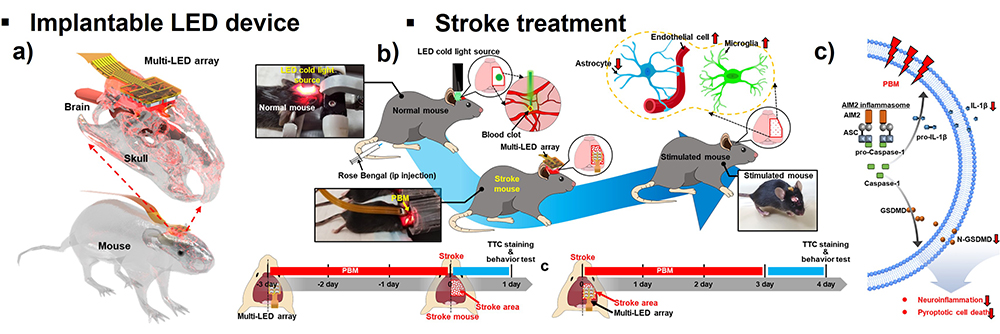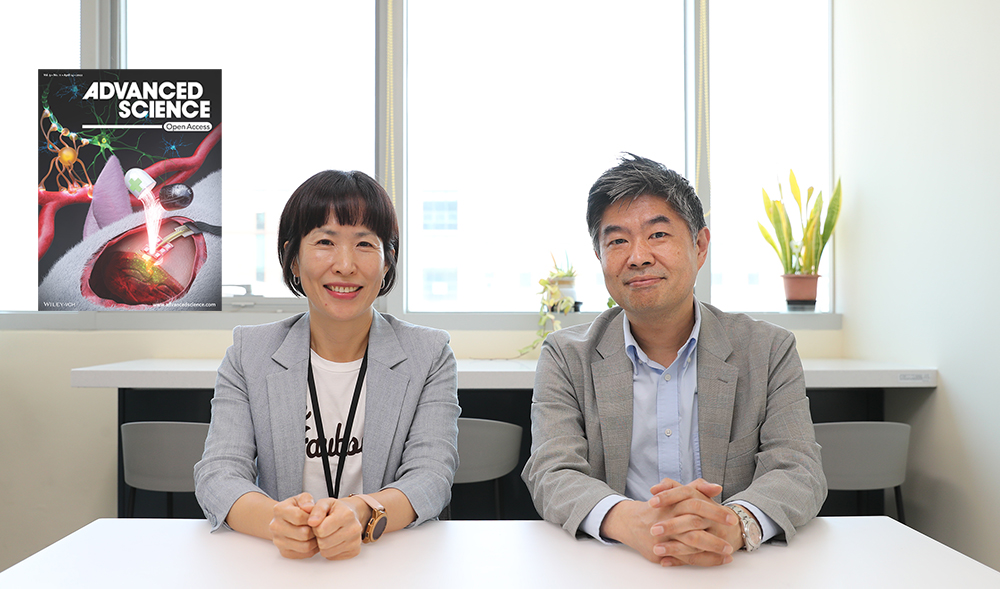- 작성일
- 2022.06.07
- 수정일
- 2022.06.07
- 작성자
- 나노
- 조회수
- 336
[PNU리서치] 홍석원 교수팀, 동물용 초소형 LED기반 광자극기기 개발해 뇌기능장애 치료 시스템 가능성 제시
한의과학과 신화경 교수팀과 광메카트로닉스공학과 홍석원 교수팀이 LED(발광다이오드)를 이용한 동물용 뇌자극기기를 개발해 광자극에 의한 뇌졸중 후 뇌기능 회복 기전을 규명했다.
광자극(photobiomodulation)은 뇌졸중 후 조직기능을 개선하고 재생능력을 향상시킬 수 있는 기술로 그 가능성을 주목 받아 왔다. 기존의 단순한 광자극 치료에서 다양한 약물, 자극패턴, 자극부위 등을 조합한 복합치료 기술 개발의 필요성이 제기되고 있는 가운데, 부산대 연구팀이 이러한 복합치료 기술 개발을 위한 연구로 정교한 자극을 동물실험에서 구현하기 위해 쥐의 신체구조에 맞는 동물용 초소형 LED기반 광자극 실험장치를 개발한 것이다.
연구팀이 개발한 광자극기기는 마우스 동물모델에서 뇌신경조절을 위해 유연한 기판을 통합하는 패키징 된 LED로 구성된 가볍고 작은 소형 전자장치 시스템이다. 이 이식형 장치 플랫폼을 사용해 뇌졸중 동물모델의 두개골에 부착해 광자극을 통해 뇌졸중 예방 및 치료효과를 연구했다.
연구 결과, 630nm LED array(배열)를 사용한 광자극이 허혈성 뇌 손상 후 뇌경색 크기 및 신경계 손상을 줄이는 데 가장 효과적이고, 특히 뇌졸중 후 만성 단계에서 공간 학습 및 기억 능력을 현저하게 향상시켰다. 이는 광자극이 AIM2 inflammasome(염증소체) 활성화 및 inflammasome-mediated pyroptosis(염증소체 매개성 파이롭토시스)를 감소시키고, microglial polarization(미세아교세포 분극)을 조절함으로써 인지기능을 회복시킨 것으로, 광자극이 잠재적으로 급성 뇌졸중 손상 및 뇌졸중 후 인지 장애에 대한 안전하고 효과적인 뇌기능 회복 기술이 될 수 있음을 보였다.

a) 광자극 적용을 위한 두개골에 이식 가능한 플렉시블 LED 전기소자 적용 개념도
b) 국소부위 적용을 통한 급성 뇌졸중 마우스 실험 과정
c) 광자극 효과에 관한 메커니즘 모델 제안
이번 연구를 통해 개발된 LED기반 광자극기기는 뇌졸중은 물론 치매, 뇌전증, 정신장애 등의 난치성 뇌질환 연구로 더욱 확장될 수 있을 것으로 기대된다.
이번 연구는 한국연구재단이 추진하는 바이오의료기술개발사업, 중견연구지원사업, 선도연구센터(ERC) 지원사업으로 수행됐다. 해당 논문은 소재 분야의 세계적인 학술지 『어드밴스드 사이언스(Advanced Science)』 4월 14일자로 출판됐고, 연구의 우수성을 인정받아 Inside back cover로 선정됐다.
- 논문 제목: Benefits of a Skull-Interfaced Flexible and Implantable Multilight Emitting Diode Array for Photobiomodulation in Ischemic Stroke(두개골에 적합한 유연하고 이식 가능한 다중 발광 다이오드 어레이 광자극기기를 이용한 허혈성 뇌졸중 연구)
- 논문 링크: https://onlinelibrary.wiley.com/doi/10.1002/advs.202104629
* 상단 사진: 『어드밴스드 사이언스(Advanced Science)』 Inside back cover로 소개된 부산대 연구 성과. 인물 왼쪽부터 논문 교신저자인 신화경 교수와 홍석원 교수
[Abstract]
Photobiomodulation (PBM) has received attention due to its potential for improving tissue function and enhancing regeneration in stroke. A lightweight, compact, and simple system of miniaturized electronic devices consisting of packaged light-emitting diodes (LEDs) that incorporates a flexible substrate for in vivo brain PBM in a mouse model is developed. Using this device platform, the preventive and therapeutic effects of PBM affixed to the exposed skull of mice in the photothrombosis and middle cerebral artery occlusion stroke model are evaluated. Among the wavelength range of 630, 850, and 940 nm LED array, the PBM with 630-nm LED array is proved to be the most effective for reducing the infarction volume and neurological impairment after ischemic stroke. Moreover, the PBM with 630 nm LED array remarkably improves the capability of spatial learning and memory in the chronic poststroke phase, attenuates AIM2 inflammasome activation and inflammasome-mediated pyroptosis, and modulates microglial polarization in the hippocampus and cortex 7 days following ischemic stroke. Thus, PBM may prevent tissue and functional damage in acute ischemic injury, thereby attenuating the development of cognitive impairment after stroke.
- Paper Title: Benefits of a Skull-Interfaced Flexible and Implantable Multilight Emitting Diode Array for Photobiomodulation in Ischemic Stroke
- Authors: Hyunha Kim, Min Jae Kim, Young Woo Kwon, Sangheon Jeon, SeoYeon Lee, ChangSeok Kim, Byung Tae Choi, YongIl Shin, Suck Won Hong, and Hwa Kyoung Shin (Pusan National University)
- URL: https://onlinelibrary.wiley.com/doi/10.1002/advs.202104629
- 첨부파일
- 첨부파일이(가) 없습니다.
